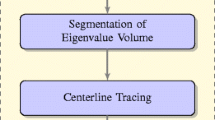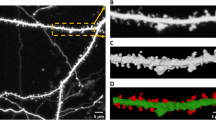Abstract
Three-dimensional segmentation and analysis of dendritic spine morphology involve two major challenges: 1) how to segment individual spines from the dendrites and 2) how to quantitatively assess the morphology of individual spines. To address these two issues, we developed software called 3dSpAn (3-dimensional Spine Analysis), based on implementing a previously published method, 3D multi-scale opening algorithm in shared intensity space. 3dSpAn consists of four modules: a) Preprocessing and Region of Interest (ROI) selection, b) Intensity thresholding and seed selection, c) Multi-scale segmentation, and d) Quantitative morphological feature extraction. In this article, we present the results of segmentation and morphological analysis for different observation methods and conditions, including in vitro and ex vivo imaging with confocal microscopy, and in vivo observations using high-resolution two-photon microscopy. In particular, we focus on software usage, the influence of adjustable parameters on the obtained results, user reproducibility, accuracy analysis, and also include a qualitative comparison with a commercial benchmark. 3dSpAn software is freely available for non-commercial use at www.3dSpAn.org.















Similar content being viewed by others
Data Availability Statement
See Information Sharing Statement.
Code Availability
See Information Sharing Statement.
Change history
01 June 2022
A Correction to this paper has been published: https://doi.org/10.1007/s12021-022-09589-0
References
Argunsah, A. O., Erdil, E., Ghani, M. U., Cortes, Y. R., Hobbiss, A. F., & Karayannis, T., Cetin, M., Israely, I., & Unay, D. (2020). SpineS: An interactive time-series analysis software for dendritic spines. bioRxiv.
Baczynska, E., Pels, K. K., Basu, S., Włodarczyk, J., & Ruszczycki, B. (2021). Quantification of Dendritic Spines Remodeling under Physiological Stimuli and in Pathological Conditions. International Journal of Molecular Sciences, 22(8), 4053.
Basu, S., Saha, P. K., Roszkowska, M., Magnowska, M., Baczynska, E., Das, N., et al. (2018). Quantitative 3-D morphometric analysis of individual dendritic spines. Scientific Reports, 8(1), 1–13.
Berry, K. P., & Nedivi, E. (2017). Spine dynamics: are they all the same?. International Journal of Molecular Sciences, 96(1), 43-55.
Brownrigg, D. R. K. (1984). The Weighted Median Filter. Communications of the ACM, 27(8), 807–818.
Caroni, P., Donato, F., & Muller, D. (2012). Structural plasticity upon learning: regulation and functions. Nature Reviews Neuroscience, 13(7), 478–490.
Chidambaram, S. B.,; Rathipriya, A. G., Bolla, S. R., Bhat, A., Ray, B., Mahalakshmi, A. M., Manivasagam, T., Thenmozhi, A. J., Essa, M. M., Guillemin, G. J., Chandra, R., & Sakharkar, M. K. (2019). Dendritic spines: Revisiting the physiological role. Progress in Neuro-Psychopharmacology and Biological Psychiatry, 92, 161–193.
Choi, J., Lee, S. E., Cho, E., Kashiwagi, Y., Okabe, S., Chang, S., & Jeong, W. K. (2019). Interactive dendritic spine analysis based on 3D morphological features. In 2019 IEEE Visualization Conference (VIS) (pp. 171–175). IEEE.
Chow, D. K., Groszer, M., Pribadi, M., Machniki, M., Carmichael, S. T., Liu, X., & Trachtenberg, J. T. (2009). Laminar and compartmental regulation of dendritic growth in mature cortex. Nature neuroscience, 12(2), 116-118.
Comery, T. A., Stamoudis, C. X., Irwin, S. A., & Greenough, W. T. (1996). Increased density of multiple-head dendritic spines on medium-sized spiny neurons of the striatum in rats reared in a complex environment. Neurobiology of Learning and Memory, 66(2), 93–96.
Driscoll, M. K., Welf, E. S., Jamieson, A. R., Dean, K. M., Isogai, T., Fiolka, R., & Danuser, G. (2019). Robust and automated detection of subcellular morphological motifs in 3D microscopy images. Nature methods, 16(10), 1037–1044.
Edril, E., Argunsah, A. O., Tasdizen, T., Unay, D., & Cetin, M. A. (2015). joint classification and segmentation approach for dendritic spine segmentation in 2-photon microscopy images in IEEE 12th International Symposium on Biomedical Imaging (ISBI), 797-800.
Fiala, J. C., Spacek, J., & Harris, K. M. (2002). Dendritic spine pathology: Cause or consequence of neurological disorders? Brain Research Reviews, 39, 29–54.
Forrest, M. P., Parnell, E., & Penzes, P. (2018). Quantitative 3-D morphometric analysis of individual dendritic spines. Nature Reviews Neuroscience, 19.
Glausier, J. R., & Lewis, D. A. (2013). Dendritic spine pathology in schizophrenia. Neuroscience, 251, 90–107.
Gribbon, K. T., & Bailey, D. G. (2004). A novel approach to real-time bilinear interpolation. In Proceedings, DELTA 2004 - Second IEEE International Workshop on Electronic Design, Test and Applications, 126–131.
Harris, K. M., & Kater, S. B. (1994). Dendritic Spines: Cellular Specializations Imparting Both Stability and Flexibility to Synaptic Function. Annual Review of Neuroscience, 17, 341–371.
Hering, H., & Sheng, M. (2001). Dentritic spines: structure, dynamics and regulation. Nature Reviews Neuroscience, 2.
Holtmaat, A., de Paola, V., Wilbrecht, L., Trachtenberg, J. T., Svoboda, K., Portera-Cailliau, C. (2001). Imaging neocortical neurons through a chronic cranial window. Cold Spring Harbor Protocols, 2012, pdb–prot069617.
Kashiwagi, Y., Higashi, T., Obashi, K., Sato, Y., Komiyama, N. H., Grant, S. G. N., & Okabe, S. (2019). Computational geometry analysis of dendritic spines by structured illumination microscopy. Nature communications, 10, 14.
Kim, B. G., Dai, H., McAtee, M., Vicini, S., & Bregman, B. S. (2007). Labeling of dendritic spines with the carbocyanine dye DiI for confocal microscopic imaging in lightly fixed cortical slices. Journal of neuroscience methods, 162, 237–243.
Krzystyniak, A., Baczynska, E., Magnowska, M., Antoniuk, S., Roszkowska, M., Zareba-Koziol, M., et al. (2019). Prophylactic Ketamine Treatment Promotes Resilience to Chronic Stress and Accelerates Recovery: Correlation with Changes in Synaptic Plasticity in the CA3 Subregion of the Hippocampus. International Journal of Molecular Sciences, 20, 1726.
Lee, K. F. H., Cary, S., & Béïque, J. C. (2012). Examining form and function of dendritic spines. In Neural Plasticity: Hindawi Publishing Corporation.
Łukasiewicz, K., Robacha, M., Bożycki, Ł, Radwanska, K., & Czajkowski, R. (2016). Simultaneous two-photon in vivo imaging of synaptic inputs and postsynaptic targets in the mouse retrosplenial cortex. Journal of Visualized Experiments, 109, e53528.
Magnowska, M., Gorkiewicz, T., Suska, A., Wawrzyniak, M., Rutkowska-Wlodarczyk, I., Kaczmarek, L., & Wlodarczyk, J. (2016). Transient ECM protease activity promotes synaptic plasticity. Scientific reports, 6, 27757.
Mancuso, J. J., Cheng, J., Yin, Z., Gilliam, J. C., Xia, X., Li, X., & Wong, S. T. C. (2014). Integration of multiscale dendritic spine structure andfunction data into systems biology models. Frontiers in Neuroanatomy, 8, 130.
Matsuzaki, M., Honkura, N., Ellis-Davies, G. C. R., & Kasai, H. (2004). Structural basis of long-term potentiation in single dendritic spines. Nature, 429, 761–766.
Okabe, S. (2020). Recent advances in computational methods for measurement of dendritic spines imaged by light microscopy. Microscopy, 69, 196-213.
Ozgur et al. (2020). biorxiv - https://www.biorxiv.org/content/10.1101/2020.09.12.294546v1. https://doi.org/10.1101/2020.09.12.294546
Qt Cross-platform software development for embedded and desktop. https://www.qt.io/. Accessed On: 05-11-2019.
Richards, D. A., Mateos, J. M., Hugel, S., de Paola, V., Caroni, P., Gähwiler, B. H., & McKinney, R. A. (2005). Glutamate induces the rapid formation of spine head protrusions in hippocampal slice cultures. Proceedings of the National Academy of Sciences, 102.
Rodriguez, A., Ehlenberger, D. B., Hof, P. R., Wearne, S. L. (2019). Rayburst sampling, an algorithm for automated three-dimensional shape analysis from laser scanning microscopy images. Nature Protocols, 2152-2161.
Rodriguez, A., Ehlenberger, D. B., Dickstein, D. L., Hof, P. R., & Wearne, S. L. (2019). Automated three-dimensional detection and shape classification of dendritic spines from fluorescence microscopy images. Plos One, 3, e1997.
Ruszczycki, B., Wlodarczyk, J., Kaczmarek, L. (2012). Method and a system for processing an image comprising dendritic spines. https://patents.google.com/patent/US20140169647
Ruszczycki, B., Szepesi, Z., Wilczynski, G. M., Bijata, M., Kalita, K., Kaczmarek, L., & Wlodarczyk, J. (2012). Sampling issues in quantitative analysis of dendritic spines morphology. BMC Bioinformatics, 13.
Ruszczycki, B., Bijata, M., Walczak, A., Wilczynski, G., & Wodarczyk, J. (2013). Contemporary Problems in Quantitative Image Analysis inStructural Neuronal Plasticity. InAdvanced Computational Approaches to Biomedical Engineering; Saha, P.K., Maulik, U.,Basu, S., Eds.;Springer: Berlin/Heidelberg, Germany. pp. 159-175.
Saha, P. K., Basu, S., & Hoffman, E. A. (2016). Multiscale Opening of Conjoined Fuzzy Objects: Theory and Applications. IEEE Transactions on Fuzzy Systems, 24, 1121–1133.
Sala, C., & Segal, M. (2014). Dendritic Spines: The Locus of Structural and Functional Plasticity. Physiological Reviews, 94, 141–188.
Singh, P. K., Hernandez-Herrera, P., Labate, D., & Papadakis, M. (2017). Automated 3-D detection of dendritic spines from in vivo two-photon image stacks. Neuroinformatics, 15(4), 303–319.
Smirnov, M. S., Garrett, T. R., & Yasuda, R. (2018). An open-source tool for analysis and automatic identification of dendritic spines using machine learning. PLoS One, 13(7).
Spires, T. L., Meyer-Luehmann, M., Stern, E. A., McLean, P. J., Skoch, J., Nguyen, P. T., et al. (2005). Dendritic spine abnormalities in amyloid precursor protein transgenic mice demonstrated by gene transfer and intravital multiphoton microscopy. Journal of Neuroscience, 25, 7278–7287.
Swanger, S. A., Yao, X., Gross, C., & Bassell, G. J. (2011). Automated 4D analysis of dendritic spine morphology: applications to stimulus-induced spine remodeling and pharmacological rescue in a disease model. Molecular Brain, 4, 38.
Szepesi, Z., Bijata, M., Ruszczycki, B., Kaczmarek, L., & Wlodarczyk, J. (2013). Matrix metalloproteinases regulate the formation of dendritic spine head protrusions during chemically induced long-term potentiation. PLoS One, 8, 63314.
Trachtenberg, J. T., Chen, B. E., Knott, G. W., Feng, G., Sanes, J. R., Welker, E., & Svoboda, K. (2002). Long-term in vivo imaging of experience-dependent synaptic plasticity in adult cortex. Nature, 420, 788.
Wong, S. T. C., Chen, X., & Xu, X. (2006). Methods and systems for the analysis of 3d microscopic neuron images. http://www.google.com.gt/patents/WO2006125188A1?cl=en
Worbs, T., & Foster, R. (2007). 4D tracking with Imaris. Bitplane Imaris: Oxford Instruments http://www.bitplane.com/learning/4d-tracking-with-imaris-immunology
Xiao, X., Djurisic, M., Hoogi, A., Sapp, R. W., Shatz, C. J., & Rubin, D. L. (2018). Automated dendritic spine detection using convolutional neural networks on maximum intensity projected microscopic volumes. Journal of neuroscience methods, 309, 25–34.
Xiao, C., Li, W., Deng, H., Chen, X., Yang, Y., Xie, Q., & Han, H. (2018). Effective automated pipeline for 3D reconstruction of synapses based on deep learning. BMC bioinformatics, 19(1), 263.
Yushkevich, P. A., Piven, J., Hazlett, H. C., Smith, R. G., Ho, S., Gee, J. C., & Gerig, G. (2006). User-guided 3D active contour segmentation of anatomical structures: significantly improved efficiency and reliability. Neuroimage, 31, 1053–8119.
Acknowledgements
This project was supported by the Department of Biotechnology, India grant: BT/PR16356/BID/7/596/2016 (S.B) and the Polish National Science Centre, grant 2017/26/E/NZ4/00637 (J.W.). N.D. acknowledges CSIR SRF Fellowship, File No. 09|096(0921)2K18 EMR-I), India. E.B. acknowledges Polish National Science Centre grant UMO-2017/27/N/NZ3/02417. M.B. acknowledges Foundation for Polish Science grant POIR.04.04.00-00-43BC/17-00. D.P. has been supported by Polish National Science Centre (2019/35/O/ST6/02484, 2020/37/B/NZ2/03757), Foundation for Polish Science co-financed by the European Union under the European Regional Development Fund (TEAM to DP). The research was co-funded by Warsaw University of Technology within the Excellence Initiative: Research University (IDUB) programme. We would like to thank Anthony Woodley for English language corrections.
Author information
Authors and Affiliations
Contributions
S.B. and J.W. conceived the study; S.B., P.K.S., D.P., J.W. performed the experimental design; N.D., S.B. developed the software; N.D., E.B., M.B., A.Z., B.R. analyzed the data; S.B., N.D., B.R, E.B., J.W, E.P., M.B. wrote the manuscript.
Corresponding authors
Ethics declarations
Conflict of interest
The authors declare that they have no conflict of interest.
Additional information
Publisher’s Note
Springer Nature remains neutral with regard to jurisdictional claims in published maps and institutional affiliations.
The original online version of this article was revised: Full information regarding the corrections made can be found in the erratum/correction for this article.
Supplementary Information
Below is the link to the electronic supplementary material.
Rights and permissions
About this article
Cite this article
Das, N., Baczynska, E., Bijata, M. et al. 3dSpAn: An interactive software for 3D segmentation and analysis of dendritic spines. Neuroinform 20, 679–698 (2022). https://doi.org/10.1007/s12021-021-09549-0
Accepted:
Published:
Issue Date:
DOI: https://doi.org/10.1007/s12021-021-09549-0




